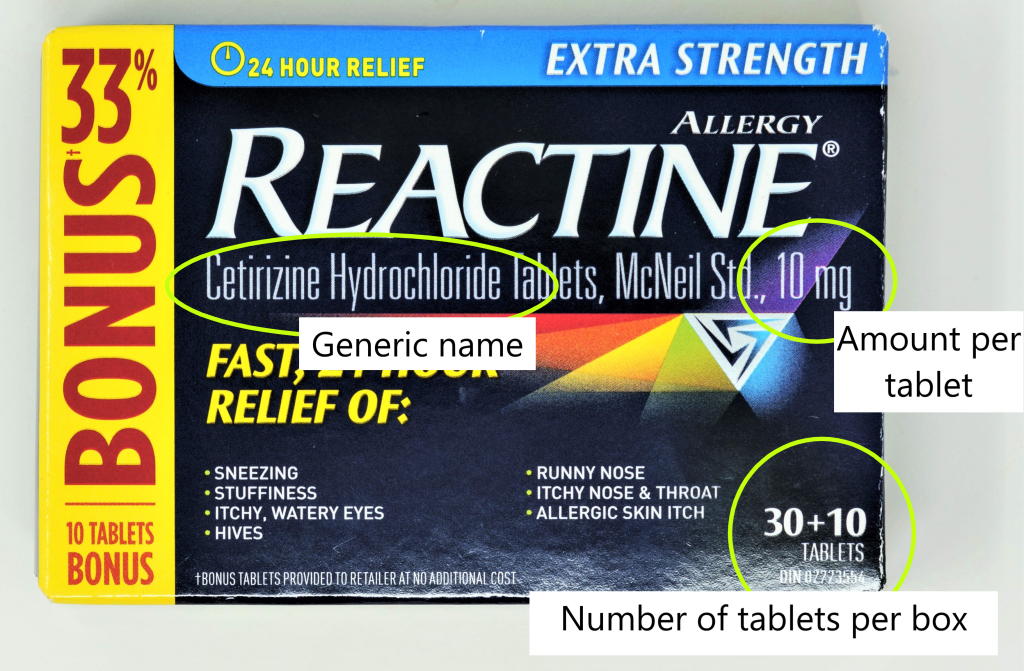14 Medication Labels
Learning Outcomes
By the end of this chapter, learners will be able to:
- describe the key components of a medication label, and
- identify key information on sample medication labels.
Medication Labels
Medication containers are labelled with various types of information about the particular medication inside. When administering medications, it is essential you understand what the numbers on the label represent in order to determine the correct amount of medication to give. Medication labels may be formatted differently, but contain particular types of information about the medication. This chapter reviews the components of the label you should be familiar with when determining how much of a medication to give.
When you read the information on the medication label, be sure to note the medication name, the quantity of medication in the container and the expiry date.
- The quantity of medication may be measured using a variety of units, such as milligrams (mg), grams (g), or international units (IU).
- For liquid medications, the total volume and concentration of medication in the container will also be written on the label.
- It is important not to confuse the concentration with the total amount of medication in the vial.
- Concentration is often given as a quantity of medication in a particular volume, which is often only part of the total volume in the container. For example, the concentration of a liquid medication could be 5 mg/1 mL. This would indicate there are 5 mg of medication in every 1 mL of liquid.
In addition to numerical information related to dose, the package may include numbers representing the expiry date, reconstitution information, lot number, and non medicinal ingredients. Other key information includes the medication name, which may be listed with both the generic and trade name in some cases, what route the medication may be used for, and the pharmaceutical company name. Alternately, some of this information may be included on the box or wrapper the medication was packaged in or on an information sheet inside the package.
In the image below, note the generic name, the milligrams of medication (amount) per tablet and the total number of tablets in the package.

14.1 Exercise: Medication label
14.2 Exercise: Viral Labels
Critical Thinking Question
When administering liquid medications, should you calculate the volume of liquid (eg. mL) or the amount of medication (eg. mg) first?
Answer:
Amount. The amount of medication is constant. The volume of liquid may change depending on the concentration of solution you are administering. It is important to know the volume you will administer as well, but it is based on the amount of medication you are giving. Ensure you know the amount of medication first, and then calculate the volume to administer, based on the concentration of the medication in the available supply.
Key Takeaways
Key components of medication labels when preparing a medication dose:
- medication name
- quantity of medication
- volume of liquid (for liquid medications)
- concentration (for liquid medications)
- expiry date
14.3 Practice Set: Reading Medication Labels
14.4 Practice Set: Reading Medication Labels
Case Studies
Scenario A: Pain Relief Tablets for Seniors
A senior named John from Lunenburg, Nova Scotia, visits the clinic for pain management. He is prescribed Acetaminophen Tablets. The medication label indicates:
- Generic name: Acetaminophen
- Strength per tablet: 500 mg/tablet
- Package contains: 50 tablets
- Expiry date: January 2026
The prescription is for 1,000 mg every 8 hours as needed for pain.
Questions:
- What is the generic name of the medication?
- How many tablets are needed for one dose?
- If John takes the medication three times a day for one week, will the bottle be enough?
Scenario B: Insulin for Diabetes Management
A nurse in Amherst, Nova Scotia, is preparing an insulin dose for a patient named Mary. The medication label reads:
- Generic name: Insulin glargine
- Concentration: 100 units/mL
- Total volume: 10 mL
- Expiry date: 30 days after opening
Mary’s doctor has prescribed 25 units once daily.
Questions:
- What is the generic name of the medication?
- How many mL should Mary use for each dose?
- Will the vial last for 30 days at this dosage?
SolutionsA) Solution:
- Generic name: Acetaminophen.
- Tablets per dose: 1,000 mg ÷ 500 mg/tablet = 2 tablets.
- Total tablets needed for one week: 2 tablets/dose × 3 doses/day × 7 days = 42 tablets.
- The bottle contains 50 tablets, so it is sufficient for one week.
B) Solution:
- Generic name: Insulin glargine.
- Amount to give per dose: 25 units ÷ (100 units/mL) = 0.25 mL.
- Total doses in the vial: 10 mL ÷ 0.25 mL = 40 doses.
- Mary needs 30 doses for 30 days, so the vial is sufficient.
Chapter Credit
Adapted from Chapter 12 Understanding Medication Labels in A Guide for Numeracy in Nursing by Julia Langham, CC BY 4.0.
Case Studies are new content.

